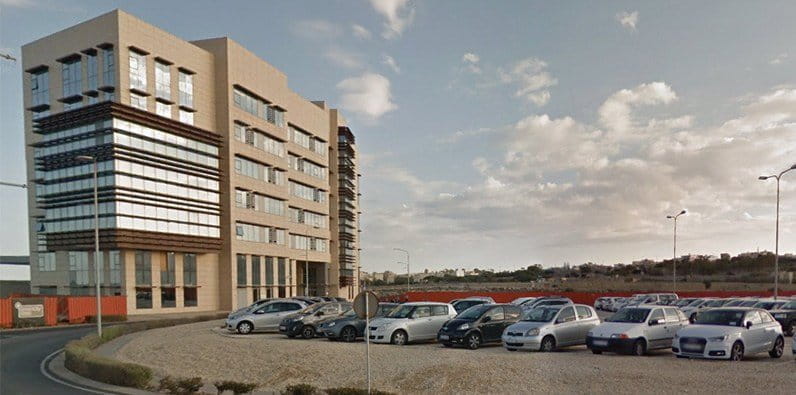Key Highlights of the Malta Gaming Authority Report
- During the first six months of 2018, MGA went through an overhaul of its regulatory framework in order to provide better protection and control over all gaming sectors under its legislative umbrella.
- Following the implementation of the 4th Anti-Money Laundering (AML) Directive, the MGA has performed an industry outreach. Additionally, the Authority has started conducting its first AML inspections.
- As part of its regulation policy, Malta Gaming Authority has undertaken a number of enforcement actions, including the issuance of 45 administrative fines. Additionally, the Authority has suspended one license and cancelled another 5.
- During the first half of 2018, the MGA’s Fit & Proper Committee refused 35 individuals and issued 30 personal verdicts. Additionally, the Authority conducted a total of 1,003 criminal probity screenings.
- The MGA has dedicated itself to its commitment to protect the players who required the Authority’s interference in various disputes with operators and has resolved a total of 1,794 complaints.
- The MGA has published an official document on the General Data Protection Regulation (GDPR). Its aim is to harmonise the data protection regulation across Europe and to protect the EU citizens’ data privacy. The new regulations also wish to change the way in which organisations across the region approach data privacy.
- The MGA continued to participate in international discussions to protect the interests of the gaming industry in Malta.
- By June 2018, a total of 300 companies held a Maltese license.
- By June 2018, the gaming industry in Malta has generated more than 6,800 full-time jobs.
Legal Initiative and Updates
The Malta Gaming Authority has undertaken a variety of legislative actions during the first half of 2018. On May 8, 2018, the Maltese Parliament approved the suggested updates to the Gaming Act and agreed that the MGA’s supervising role needed to be strengthened. The decision was especially related to the 4th Anti-Money Laundering Directive, which came into force in June 2017 and made all operators subject of the anti-money laundering legislation. The Authority has also collaborated with the Financial Intelligence Analysis Unit (FIAU) to assure an effective AML framework. Additionally, the MGA has worked on various projects in order to reach out to the Gambling Industry and provide information on the anti-money-laundering matter. The Authority has also participated in various EU meetings, discussing the development of the gambling industry. During the Gambling Regulators European Forum meeting in Prague, the MGA expressed its interest in maintaining and strengthening its ties with other European Regulators. Furthermore, in anticipation of the implementation of the EU General Data Protection Regulation (2016/679), the MGA issued explanatory industry guidelines on how the operators can develop the necessary policies to ensure compliance with the Regulation.
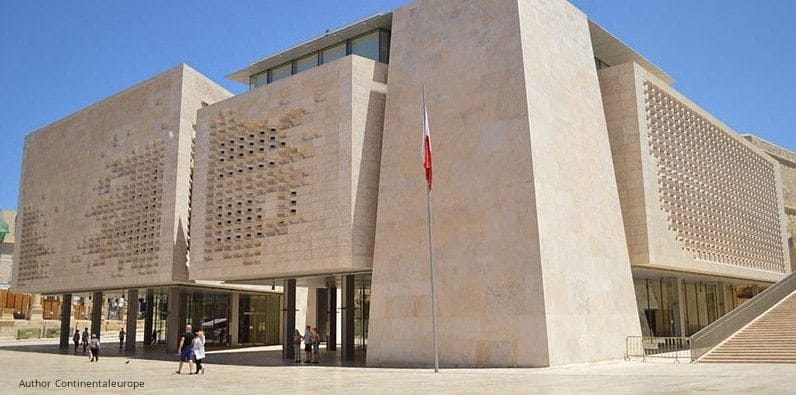
Development of Licensing Functions
During the first half of 2018, the Malta Gaming Authority has enhanced its supervisory and regulatory role during the onboarding stage of new licensees and throughout their licence duration. Prior to issuing a licence, the MGA makes sure that all Malta-based operators, both local and foreign have taken all necessary measure to become a proper fit to conduct gaming operations from Malta. During the period from January to June 2018, 115 decisions requesting the approval of the Authority, were taken. A total of 35 individual or companies were refused. Additionally, the MGA performed 1,003 Criminal Probity Screening Checks to ensure that all individuals and companies involved in remote and land-based gambling were fit and proper to conduct operations. The checks’ aim was to ensure that none of the gambling operations was used for illegal activities. Additionally, the MGA has undertaken a number of investigations, concerning the operators’ illicit activities. As a result, the Authority issued 45 administrative fines, suspended one licence and cancelled another five.
General Overview of the Maltese Gaming Industry
A significant part of the MGA report was dedicated to the performance of the regulated gambling industry for the period between January and June 2018. The analysis included the industry’s economic development, employment and tax revenue results and demand trends and supply capabilities of operators under the Maltese Jurisdictions. For your convenience, we will summarise and analyse the numerical information.
Economic Gambling Statistics in Malta
According to the published results, the Maltese gambling industry demonstrated significant economic growth throughout the first half of 2018. According to approximate estimations, the gaming industry has generated around €623 million profits during the first six months of 2018. This is 12.1% of the total value of the Maltese economy. The employment rate of the Maltese gambling industry has also grown significantly with 6,849 provided at the first half of 2018. This is 150 more jobs than the ones available in 2017. The Gaming tax has also generated an increase of 1.5% or a total of €29.4 million tax profits, which is €400,000 more than the numbers generated during the same period in 2017. The results are also due to the fact that the number of approved licenses has also increased, and thus more operators have received legal permission to operate on Maltese grounds. Based on the positive development, demonstrated by the Maltese gambling industry, the experts are expecting further economic growth during the second half of 2018 and throughout 2019.
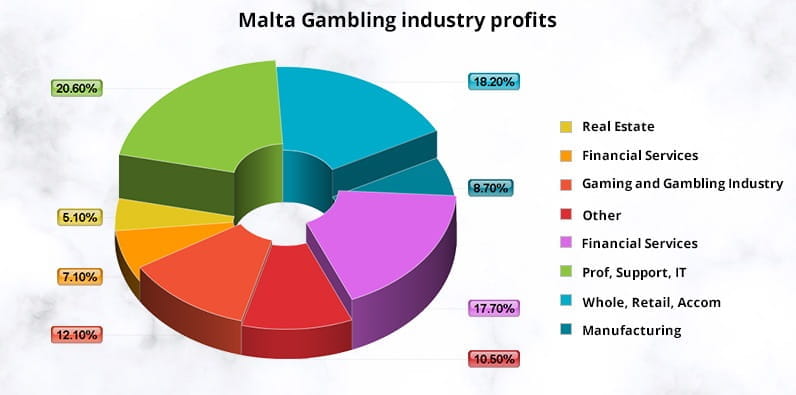
Demographic Gambling Statistics in Malta
The land-based casinos in Malta also demonstrated a significant growth by welcoming 3.6% more visitors than they did in the first half of 2017. A total of 61,214 new player registrations were handled, while according to the statistics there were also many players, registered at more than one casino. The results suggest a growth of 8.3% of new casino players compared to the number of visitors received in 2017. The report also calculated a significant growth of non-Maltese visitors to the land-based casinos. The growth of foreign casino players is also an indicator that the Maltese tourism has also generated economic growth during the first half of 2018. The Demographic statistics also demonstrated a significant growth of the casino visitors aged 35-54. The rest of the demographic information generated growth of the visitors of all other age groups, with the exception of the one of 65+. However, the age group of the elderly still formed 30% of all casino visitors throughout the first half of 2018.
Maltese Online Gambling Overview
A big part of the MGA Interim Report focused on remote gambling. Following the updated Gaming Act, there has been an increase of 18.5% of the licences issued between January and June 2018 compared to the same period in 2017. In terms of numbers, the MGA received 121 licence applications and approved 62 of them. Meanwhile, 6 ongoing licences were cancelled and 1 was suspended by the Authority’s Enforcement Unit. Thus, in the first half of 2018, there were 291 companies holding a remote gaming license, or 1.4% more than they were during the same period in 2017. Inevitably, the Authority registered a growth of 21.9% of the customer accounts made at online gambling ventures. The total number of online players also grew, especially of those aged between 25-34, as they formed 28.2% of the remote gaming players on websites licensed by the MGA. According to the information stated in the report, the rest of the groups remained fairly stable.
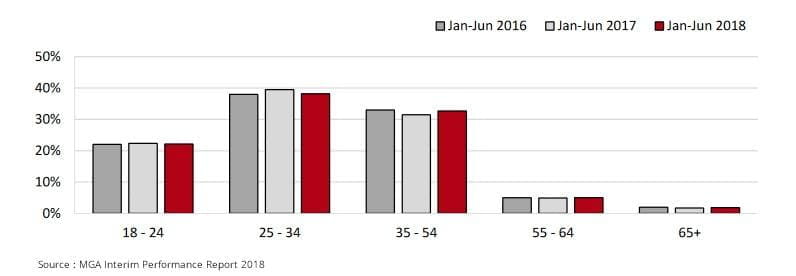
Preferred Payment Methods
In contrast to our expectation and to what has been noted in other reports, for the period between January and June 2018, players preferred to make deposits mostly through bank transfers. According to the information stated in the report, the method was used by 32% of the customers of the MGA licensed casinos, which as an increase of 7% over the same period in 2017. The credit and debit cards were the second preferred payment method, which was chosen by 31.5% of the online gamblers. Meanwhile, 23.3% of them decided to pay through e-wallets.
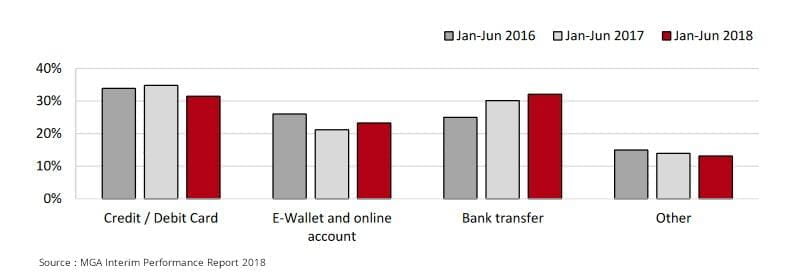
When it comes to withdrawals, the bank transfers remained the most preferred method, chosen by 49.7% of the players. It must be noted, however, that the method is 6% less popular than it used to be during the first half of 2017. The e-wallets formed 28.2% of all withdrawal methods used during the first six months of 2018, which demonstrates an increase of 11.7% compared to the same period in 2017. The credit and debit cards were the least popular withdrawal method, with a share of 19.7% and a total drop of 9.4% compared to the same period in 2017.
Online Gambling Statistics: Gross Gaming Revenue
During the period between January and June 2018, it was estimated that 56% of the total Gross Gaming Revenue (GGR) came from online casinos. According to the statistics stated in the report, 77% of the GGR came from slot games, 18.5% from table games and the remaining 4.6% was generated by other games such as poker, scratch cards etc. Inevitably, part of the GGR was generated through online betting sites. 76.7% of the revenue was generated through football bets, 8.6% through betting on tennis games, 6.5% through basketball bets and the remaining 8.2% were generated through betting on other sports such as hockey, volleyball, baseball and others. Meanwhile, the GGR generated through poker networks, peer to peer gaming and network portals also demonstrated a significant growth compared to the numbers generated during the first half of 2017. The biggest increase was noted in the poker games, which generated 73% of the total GGR. It is 39% more than the poker profits generated during the first six months of 2017.
| Type of Product: | Type of Games: | Type of Games: | Type of Games: |
|---|---|---|---|
| Online Casinos – 56%/100% | Slot Games 77% | Table Gamws 18.5% | Other Games 4.6% |
| Betting Sites 36.2%/100% | Football Bets 76.7% | Tennis Bets 8.6% | Basketball & Others 14.7% |
| Poker, P2P Networks 7.8%/100% | Poker 73% | Betting Exchange 19% | Bingo & Others 9% |
Online Gambling Statistics: Tax and Employment
According to the information presented in the MGA Report, the total tax payable by remote gambling operators during the first half of 2018 was around €13.6 million, which is an increase of 1.9% compared with the same period in 2017. The largest portion of betting taxes comes from betting websites, while the online casinos and lotteries generate 24.8% of the total taxes.
The online gambling companies have also produced a large number of job positions and have hired a total of 6,021 employees. The recent number demonstrate a significant growth of the employment rate as all the employees hired by the industry by the end of 2017 was 5,861.
Conclusion: MGA Report Summary
The information presented in the MGA Interim Report for the first half of 2018 followed the development and growth of the gambling industry. It is important to note that the report was referring only to MGA licensed European gambling ventures. Nevertheless, it gave us a clear overview of the fast development of the gambling industry. Just like Malta’s Gaming Act, the European gambling laws are constantly changing and undoubtedly affecting the iGaming industry in general. However, the changes noted in the first six months of 2018 were rather positive as there was clear economic growth, more possibilities for employment and improved control over the gambling industry. We hope that our article has been useful for you. For further information on the Maltese gambling laws, we recommend you read our dedicated page about Maltese Casinos. The report for the rest of 2018 is expected to be revealed in June 2019. Meanwhile, we will keep you informed of all the changes that the gambling industry goes through.
